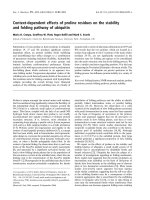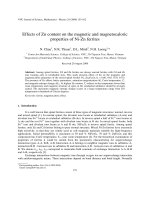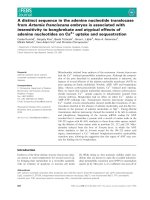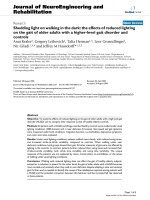The Effects of ASE Noise and the Position of EDFA Amplifier on Multi-Wavelength OCDM-Based Long-Reach Passive Optical Networks
Bạn đang xem bản rút gọn của tài liệu. Xem và tải ngay bản đầy đủ của tài liệu tại đây (470.26 KB, 10 trang )
VNU Journal of Natural Sciences and Technology, Vol. 30, No. 1 (2014) 58-67
58
The Effects of ASE Noise and the Position of
EDFA Amplifier on Multi-Wavelength OCDM-Based Long-
Reach Passive Optical Networks
Bùi Trung Ninh
1
, Phạm Văn Hội
2
, Đặng Thế Ngọc
3
,
Phạm Tuấn Anh
4
, Nguyễn Quốc Tuấn
1,
*
1
Department of Networks and Communications Systems, VNU University of Engineering and Technology
2
Institute of Materials Science, VAST, 18 Hoàng Quốc Việt, Cầu Giấy, Hanoi, Vietnam
3
Faculty of Telecommunications, Posts and Telecom. Inst. Tech., Hanoi city, Vietnam
4
Computer Communications Lab. The University of Aizu, Aizu-Wakamatsu city, Fukushima, Japan
Received 05 November 2013
Revised 19 November 2013; accepted 29 November 2013
Abstract: In this paper, we investigate effects of Erbium-doped fiber amplifier (EDFA) amplified
spontaneous emission (ASE) noise on the performance of multi-wavelength OCDMA-based Long-
Reach Passive Optical Networks. In addition, other noise and interference such as shot noise,
thermal noise, beat noise, and multiple-access interference (MAI) are included in our theoretical
analysis and simulation. We found that the location of EDFA on the link between OLT and ONUs
plays an important role in network design since it affects network performance. Analytical results
show that, to achieve low bit error rate, the EDFA should be located around 10 to 20 km from
OLT when total link distance of 90 km.
Keywords: Erbium-doped fiber amplifier (EDFA), optical code-division multiplexing (OCDM),
amplified spontaneous emission (ASE), multiple-access interference (MAI).
1. Introduction
∗
∗∗
∗
The explosive demand for bandwidth is
leading to the deployment of passive optical
networks (PONs), which are able to bring the
high-capacity optical fiber closer to the
residential homes and small businesses. Long-
reach (LR) PON is a recently proposed cost-
effective architecture for combining the metro
_______
∗
Corresponding author. Tel: 84-913301974.
E-mail:
and access networks. This architecture allows
the extention of access networks from today's
standard of 20 km to 100 km with protection
mechanism [1-3].
A number of LR optical access technologies
have been proposed. Initially, the networks
were single channel, where a single wavelength
is shared between all users, using time division
multiplexing (TDM). These networks were
followed by wavelength division multiplexing
(WDM) ones that shared a number of
B.T. Ninh et al. / VNU Journal of Natural Sciences and Technology, Vol. 30, No. 1 (2014) 58-67
59
wavelengths between groups of users. Recently,
optical code-division multiplexing (OCDM) has
been regarded as a promising candidate thanks
to its advantages over conventional techniques,
including asynchronous access efficient use of
resource, scalability and inherent security [4, 5].
In OCDM, the signal can be encoded using
the time domain, the frequency domain, or a
combination of the two [6]. In a time-domain
encoding system, the signal is encoded by time
spreading of an optical pulse. The system is
spectrally inefficient as a long code word is
usually required to maintain a low cross-
correlation. In the frequency domain, by using
multiple wavelengths for signal encoding,
spectral amplitude coding (SAC) OCDM [7, 8]
can offer a better spectral efficiency. Another
important advantage of SAC/OCDM is that
multiple-access interference (MAI), in theory,
can be eliminated by using a balance detection
receiver. In addition, unlike other frequency-
domain systems that use phase for signal
encoding, SAC/OCDM can use incoherent
sources, which allows for simpler and cheaper
systems. This feature is very important,
especially in the access network environment
where construction cost is one of the most
critical issues.
In this paper, we therefore propose a novel
architecture of a LR-PON using SAC/OCDM.
To reach a long transmission distance, an
Erbium-doped fiber amplifier (EDFA) is
located on the link between optical line terminal
(OLT) and optical network units (ONUs).
However such an EDFA also generates
amplified spontaneous emission (ASE) noise,
which will limit system performance to an
electrical signal to noise ratio at the photodiode
determined by the spontaneous-spontaneous
and carrier-spontaneous beat noise. Thus, based
on proposed architecture, we analyze the effects
of EDFA noise, i.e. ASE noise, on the
performance of OCDM-based LR-PON. Other
noise and interference such as shot noise,
thermal noise, beat noise, and multiple-access
interference (MAI) are also included in our
theoretical analysis and simulation. In order to
achieve a good performance, we will try to find
the best location to put the EDFA in the
network.
The rest of this paper is organized as
follows. In Section II, we present the
architecture of an OCDM-based LR-PON. The
theoretical analysis of the performance of LR-
PON is presented in Section III. In Section IV,
we show the simulation setup of an OCDM-
based LR-PON, the simulation results, and
discussion. Finally, Section V concludes the
paper.
2. OCDM-based LR-PON Architecture
A SAC/OCDM-based LR-PON architecture
is illustrated in Fig. 1. It consists of a shared
fiber that originates from an OLT. At a point
close to the customer premises, a passive
optical splitter is used to connect each ONU to
the main fiber.
At the OLT, downstream traffics sending to
K users are encoded by spectral encoders,
which can be implemented using the well-
studied fiber Bragg grating (FBG) structure [9].
The spectral encoders are controlled by
different codes denoted as C
m
with m=1, 2,…,
K. At each spectral encoder, a broadband
(multi-wavelength) source, whose number of
wavelengths are N
W
, is first on-off keying
(OOK) modulated by binary data. Next,
depending on the signature code (C
m
),
wavelengths corresponding to chips ``1" in a
signature code are blocked while others can
B.T. Ninh et al. / VNU Journal of Natural Sciences and Technology, Vol. 30, No. 1 (2014) 58-67
60
pass through. As a result, each binary bit ``1" is
represented by a multi-wavelength pulse while
no signal is transmitted in case of binary bit
``0". Multi-wavelength pulse from each encoder
is then combined at a K: 1 combiner and then
transmitted into the optical fiber. To
compensate fiber loss and the various coupler
losses, an EDFA optical amplifier is placed on
the link at the distance of L
1
(km) from OLT
while the distance from the EDFA amplifier to
the splitter is L
2
(km). All wavelengths are
amplified simultaneously while passing through
the amplifier thanks to its large bandwidth. The
average gain of optical amplifier is denoted as
G.
Each ONU receives the signals not only
from desired encoder (i.e., data signal) but also
from remaining encoders (i.e., MAI signal).
There are two decoders at each ONU. The first
decoder has the same characteristic with the
desired encoder while the second one has
reverse characteristic. It means that all
wavelengths corresponding to chips ``0" of C
m
are blocked by the second decoder.
The signature codes used in SAC/OCDM
systems are designed to have a fixed in-phase
cross-correlation value so that the number of
wavelengths passing through each decoder, in
the case of an interfering signal (from undesired
decoders), are the same. Because the decoded
signal from the two decoders is detected by two
photodetectors (PD1 and PD2) connected in a
balanced fashion on the additive and subtractive
branches, all interfering signals (i.e., MAI) can
be eliminated [7].
3. Theoretical Analysis
In this system, we use the Hadamard code,
whose weight and in-phase cross correlation
can be represented by its length (N). Let C
m
and
C
n
be two code vectors, the correlation between
these two vectors can be expressed as.
(
)
( )
, , ,
1
/ 2
( )
/ 4
m n
N
C C m i n i
i
N m n
R C C
N m n
=
=
= =
≠
∑
(1)
Let R refers to the responsivity of the
photodiode and P
tx
to transmitted optical power,
N
W
to number of wavelengths, K is number of
active users, the data current generated by the
optical data signal at the output of PD
1
and PD
2
can be respectively expressed as
1 2
1 2
( )/10
W
W
( )/10
W
W
1
( ) 10
2 2
1
( ) 10
2
L L
tx
data
L L
tx
data
P
N
I RG N
K N
P
I RG N N
K N
α
α
− ++
− +
−
= −
= −
(2)
where
α
is the fiber attenuation coefficient in
dB/km. The total data current, therefore, can be
expressed as
( )
( )
1 2
( )/10
W
1
10 1
2 2
0
0
L L
tx
data data data
P N
RG bit
K N
I I I
bit
α
− +
+ −
= − =
(3)
The photocurrents caused by the MAI
signals from interfering encoders when they
pass the PD1 and PD2 are given by
1 2
( )/10
W
W
1 3
( ) 10
2 4
L L
tx
MAI MAI
P N
I I RG N
K N
α
− ++ −
= = −
(4)
Due to ASE that is caused by the amplifier,
there is also ASE noise current at the output of
two photodetectors, which can be expressed as
2
/10
1
( 1) 10
2
L
ASE ASE sp opt
I I Rhfn G B
K
α
−+ −
= = −
(5)
B.T. Ninh et al. / VNU Journal of Natural Sciences and Technology, Vol. 30, No. 1 (2014) 58-67
61
Combiner K:1
Splitter 1:K
EDFA
Fig. 1. Block diagram of a SAC/OCDM-based LR-PON.
Where
h
is Planck's constant;
f
is the
optical frequency;
opt
B
is the optical
bandwidth; and
sp
n
is the spontaneous-
emission factor (or the population-inversion
factor).
Other noise that should be taken into
account at the ONU includes the thermal noise,
shot noise, and beat noise [10]. First, the
variance of the thermal noise can be written as
2
4
B
th
L
K TB
R
σ
=
(6)
Where,
B
K
is Boltzman's constant,
T
is
the receiver temperature,
B
is the bit rate, and
L
R
is the load resistance.
Next, the variance of the shot noise, which
is generated by data, ASE, and MAI signal, is
given by
1 2
1 2
2
2
- ( )/10
- ( )/10
- /10
2 ( ) 2 ( )
2 ( )
1 3
(2 )10
2
2 3
( 1) ( )10
4
2
( 1) 10
shot data data MAI MAI
ASE ASE
L L
tx
W
W
L L
tx
W
W
L
sp opt
qB I I qB I I
qB I I
P N
qBRG N
K N
P N
K qBRG N
K N
qBRhfn G B
K
α
α
α
σ
+ − + −
+ −
+
+
= + + +
+ +
= −
+ − −
+ −
(7)
The last one is beat noise current. It consists
of the signal-ASE beat noise, the ASE-ASE
beat noise (beating between the spectral
components of the added amplifier ASE), the
MAI-ASE beat noise and the signal-signal beat
noise. The variance of the beat noise is given by
Eq. (8).
B.T. Ninh et al. / VNU Journal of Natural Sciences and Technology, Vol. 30, No. 1 (2014) 58-67
62
( )
2 2 2
2
2
2
( 2 )
1
( ) [( ) ( ) ]
2
( 2 )
1
( ) ( 1)( )
2
1
1 ( 1)[( ) ( )
2 2
o p t
b e a t da ta A S E d a ta AS E A S E A S E
o p t o p t
o p t
M A I A S E M A I A S E d a ta M A I d a t a M A I
o p t o p t
M A I M A I
B B B
B
I I I I I I
B B
B B B
B
I I I I K I I I I
B B
K
K I I
σ
+ + − − + −
+ + − − + + − −
+ −
−
= + + +
−
+ + + − +
+ − − +
( )
( )
( )
1 2
1 2
2
2
/1 0
2
2
/1 0
2 2 2
2
( 2 )
]
( 2 )
1 3
2 1 0 ( )
2 2
1 3
( 1) 1 0
4
1 3
1 ( ) [( )( )
8 2 4
o p t
o p t
L L
o p t
tx
W A S E A S E
W o p t o p t
L L
tx
W A S E
W o p t
tx
W W
W
B B B
B
B B B
P N B
R G N I I
K N B B
P N B
K R G N I
K N B
P N N
K R G N N
K N
α
α
− +
− +
−
−
= − +
+ − −
+ − − −
( )
( )
(
)
1 2
1 2
/1 0
2
/1 0
2 2 2
2 2
( 2 )
3
( )( )] 1 0
4
( 2 )
1 3
1 ( 1) ( ) ( ) 1 0
4 2 4
L L
o p t
W W
o p t
L L
o p t
tx
W
W o p t
B B B
N
N N N
B
B B B
K P N
K R G N
K N B
α
α
− +
− +
−
+ − −
−
+ − − −
(8)
The total variance of the noise current is the
sum of all variances of thermal noise, shot
noise, beat noise and can be written as
2 2 2 2
total th shot beat
σ σ σ σ
= + +
(7)
Finally, the bit error rate (BER) can be
calculated as
1
2
2
Q
BER erfc
=
(8)
Where
(
)
.
erfc
is the complementary error
function, and Q is written as [11]
(
)
(
)
2 2
1 0
(1) (0)
data data
total total
I I
Q
σ σ
−
=
+
(9)
where
(1)
data
I
and
(0)
data
I
are the data
currents that can be derived from Eq. (3) for bit
“1” and bit “0”, respectively. Both
2
(1)
total
σ
and
2
(0)
total
σ
are calculated using Eq. (9).
However, when
2
(0)
total
σ
is computed, the
value of
data
I
+
and
data
I
−
should be zero in all
related equations.
Figure 2 shows noise power as a function of
the transmitted power for bit rate of 1 Gbps, 3
users, optical bandwidth of 100 nm and optical
amplifier gain of 20 dB. The noise terms
contributing significantly to
2
total
σ
are drawn
separately. The beating of the signal-signal and
the signal-ASE clearly dominate all other noise
terms. It can be said that ASE noise has
significantly impact on performance of the
system.
-40 -30 -20 -10 0 10 20 30
-200
-180
-160
-140
-120
-100
-80
-60
-40
-20
Transmitted power (dBm)
Noise (dBm)
Shot noise
Beat noise signal-ASE
Beat noise signal-signal
Total noise
Beat noise ASE-ASE
Thermal noise
Beat noise ASE-ASE
Beat noise signal-signal
Total noise
Shot noise
Thermal noise
Fig. 2. Noise power as a function of the transmitted
power with K=3 users, Rb=1 Gbps, G=20 dB.
B.T. Ninh et al. / VNU Journal of Natural Sciences and Technology, Vol. 30, No. 1 (2014) 58-67
63
4. Simulation setup and results
4.1. Simulation Setup
The simulation of SAC/OCDM-based LR-
PON is carried out on OptiSystem, a
comprehensive software design suite that
enables users to plan, test, and simulate optical
links in the transmission layer of modern
optical networks [12]. The block diagram of the
simulation model is shown in Fig. 3. The signal
spectrums at the outputs of the modulator,
encoder and decoders are also illustrated in the
figure.
Three downstream traffics are generated by
three PRBS generators, which generate pseudo
random bit sequences. These bit sequences are
then used to control NRZ generators to generate
non-return-to-zero signals. OOK modulation
between a NRZ signal and a multi-wavelength
signal that is generated by a white light source
is carried out by using a Mach-Zender
modulator. Finally, multi-wavelength OOK
signals are encoded at encoders, which are
constructed from FBGs.
A power combiner will combine the signals
from different encoders then transmit them into
the first optical fiber. The signals then will be
amplified by an EDFA amplifier and input into
the second optical fiber.
In the receiver side, two power spliters are
used. The first one is responsible to deliver the
signals to all ONUs. The second one is located
at each ONU to split the received signals into
two parts for two decoders, which are also
constructed from FBGs. Decoded signals are
converted into photocurrents by using two PIN
photodetector that are connected to a electrical
substractor to create a balance detector. Finally,
BER of the received signal is analyzed by using
a BER analyzer in combination with a low pass
Bessel filter.
4.2. Simulation Results
Simulations have been carried out to study
the effects of ASE noise and the position of
EDFA amplifier on the performance of
SAC/OCDM-based LR-PON. Key parameters
used for this simulation are listed in Table 1.
Table 1: Parameters used for system simulations.
Figure 3. Simulation model of a SAC/OCDMA-based LR-PON.
B.T. Ninh et al. / VNU Journal of Natural Sciences and Technology, Vol. 30, No. 1 (2014) 58-67
64
We can observe spectrum of signals at the
outputs of modulator, encoder and decoders as
shown in Fig. 3. After going through the
encoder, spectrum of signal is removed
/ 2
N
(i.e., 4) wavelengths. It will be unchanged while
passing through decoder 1 and is further
removed
/ 2
N
wavelengths while passing
through decoder 2. Thus, the remaining
wavelengths in spectrum of the signal at the
output of decoder 2 are
( )
W
N N
−
.
In figure 4 and 5, we fix
20
G
=
dB and
total link distance of 90 km. We investigate
BER versus transmitted power for different two
values of L
1
(L
1
= 30 km and L
1
= 60 km) from
OLT to ONUs. We evaluate BER for two cases,
with and without ASE noise. It is seen that the
effect of ASE increases with distance L
1
. In
these figures, dashed lines are the simulation
results and solid lines are the theoretical results.
They are rather close (separated by
approximately 0.5 dB). That means the BER
calculation of the simulation system is correct.
More specially, the power penalty due to ASE
noise at BER 10
-9
is about 2 dB when L
1
= 30
km. When L
1
= 60 km, it increase to 4 dB. It is
because, according to Eq. 5, ASE noise current
is inversely proportional to L
2
. It means that
I
ASE
strong when L
2
is short or L
1
is large. It is
the same for both simulation and theoretical results.
-6 -4 -2 0 2 4
10
-10
10
-8
10
-6
10
-4
10
-2
10
0
Transmitted power P
tx
(dBm)
BER
Theoretical-BER, L
1
=30km, without ASE
Theoretical-BER, L
1
=30km, with ASE
Simulation-BER, L
1
=30km, without ASE
Simulation-BER, L
1
=30km, with ASE
Fig. 4. BER vs. transmitted power (P
tx
) with K=3
users, R
b
=1 Gbps, L
1
=30 km.
-6 -4 -2 0 2 4
10
-10
10
-8
10
-6
10
-4
10
-2
10
0
Transmitted power P
tx
(dBm)
BER
Theoretical-BER, L
1
=60km, without ASE
Theoretical-BER, L
1
=60km, with ASE
Simulation-BER, L
1
=60km, without ASE
Simulation-BER, L
1
=60km, with ASE
Fig. 5. BER vs. transmitted power (P
tx
) with K=3
users, R
b
=1 Gbps, L
1
=60 km.
Figure 6 and 7 show the dependence of
BER on the position of EDFA amplifier on link
for two different values of transmitted power,
P
tx
=-4 dBm and P
tx
=-2 dBm. We can see that, in
the absence of ASE, BER reduces when L
1
increases. However, when ASE noise is
considered, the longer L
1
is, the worse BER is.
The values of L
1
at which the lowest BER can
be achieved is the range of 10 km to 20 km.
Here, dashed simulation BER lines and solid
theoretical lines are parallel and rather close,
that means simulation results are correct.
0 20 40 60 80
10
-10
10
-8
10
-6
10
-4
10
-2
Distance L
1
(km)
BER
Theoretical-BER, P
tx
=-4dBm, without ASE
Theoretical-BER, P
tx
=-4dBm, with ASE
Simulation-BER, P
tx
=-4dBm, without ASE
Simulation-BER, P
tx
=-4dBm, with ASE
Fig. 6. BER vs. the link distance (L
1
) with K=3
users, R
b
=1 Gbps, G=20 dB, P
tx
=-4 dBm, and total
link distance L
1
+L
2
=90 km.
B.T. Ninh et al. / VNU Journal of Natural Sciences and Technology, Vol. 30, No. 1 (2014) 58-67
65
0 20 40 60 80
10
-10
10
-9
10
-8
10
-7
10
-6
10
-5
Distance L
1
(km)
BER
Theoretical-BER, P
tx
=-2dBm, without ASE
Theoretical-BER, P
tx
=-2dBm, with ASE
Simulation-BER, P
tx
=-2dBm, without ASE
Simulation-BER, P
tx
=-2dBm, with ASE
Fig. 7. BER vs. the link distance (L
1
) with K=3
users, R
b
=1 Gbps, G=20 dB, P
tx
=-2 dBm, and total
link distance L
1
+L
2
=90 km.
Figure 8 shows the BER of the system
versus the number of active users when each
user bit rate is 1 Gbps and transmitted power
P
tx
=-4 dBm for two different values of the link
distance L
1
(30 and 60 km), with and without
ASE noise. It is seen that when L
1
= 30 km then
two curves are quite close to each other.
However, the number of active users will
decrease when link distance L
1
increase to 60
km in the present of ASE noise. That means,
the effect of the position of EDFA and ASE
noise on number of active users are
considerable.
0 10 20 30 40 50
10
-10
10
-8
10
-6
10
-4
10
-2
10
0
Number of active users (K)
BER
P
tx
=-4dBm, L
1
=30km, without ASE
P
tx
=-4dBm, L
1
=30km, with ASE
P
tx
=-4dBm, L
1
=60km, without ASE
P
tx
=-4dBm, L
1
=60km, with ASE
Fig. 8. BER vs. the number of active users (K) with
R
b
=1 Gbps, G=20 dB, P
tx
=-4 dBm, and total link
distance L
1
+L
2
=90 km.
Other useful information for network
design can be obtained from Fig. 9, where the
required EDFA gain that is corresponding to a
specific distance of L
1
at BER=10
-9
can be
found. Based on this result, we are able to
determine the required EDFA gain
corresponding to the specific value of L
1
or the
location of EDFA on the link.
0 20 40 60 80
10
15
20
25
30
35
40
L
1
(Km)
G (dB)
P
tx
=-4 with ASE
P
tx
=-2 with ASE
P
tx
= 0 with ASE
Fig. 9. G vs. the link distance (L
1
) with K=3 users,
R
b
=1 Gbps, BER=10
-9
, and total link distance
L
1
+L
2
=90 km.
5. Conclusion
In this paper, we have proposed a model of
LR-PON using multi-wavelength OCDM and
EDFA. Moreover, we analyzed the effects of
ASE noise on the performance of OCDM-based
LR-PON. Other noise and interference such as
shot noise, thermal noise, beat noise, and MAI
are included in our theoretical analysis and
simulation. We found that the location of
EDFA on the link between OLT and ONUs
plays an important role in network design since
it affects on the network performance.
According to the numerical results, to achieve
low bit error rate, the EDFA should be located
around 10 to 20 km from OLT when total link
distance (i.e., L
1
+ L
2
) of 90 km.
B.T. Ninh et al. / VNU Journal of Natural Sciences and Technology, Vol. 30, No. 1 (2014) 58-67
66
Acknowledgment
This work has been supported in part by
Vietnam National University (VNU-Hanoi)
under the project of Teaching Research
Improvement Grant (TRIG), and the 2013
Project of University of Engineering and
Technology.
References
[1] Elaine Wong, “Next-Generation Broadband
Access Networks and Tech-nologies,” J. of
Lightwave Technol., vol. 30, no. 4, pp. 597-
608, Feb.2012.
[2] R. P. Davey, D. B. Grossman, M. Rasztovits-
Wiech, D. B. Payne, D.Nesset, A. R. A. E.
Kelly, S. Appathurai, and S H. Yang, “Long-
reach passive optical networks,” J. of
Lightwave Technol., vol. 27, no. 3, pp.273-291,
Feb. 2009.
[3] Shea, D.P.; Mitchell, J.E., “Long-Reach Optical
Access Technologies,” IEEE Network, vol. 21,
no. 5, pp. 5–11, Sept.–Oct. 2007.
[4] A. Stok and E. H. Sargent, “The role of optical
CDMA in access networks,” IEEE Commun.
Mag., vol. 40, no. 9, pp. 83–87, Sep. 2002.
[5] R. F. Ormondroyd, and M. M. Mustapha,
“Optically orthogonal CDMA system
performance with optical amplifier and
photodetector noise,” IEEE Photonics
Technology Letters, vol. 11, no. 5, pp. 617-619,
May.1999.
[6] K. Fouli and M. Maier, “OCDMA and optical
coding: principles, applications, and
challenges,” IEEE Commun. Mag., vol. 45, no.
8, pp.27-34, Aug. 2007.
[7] D. Zaccarin and M. Kavehrad, “An optical
CDMA system based on spectral encoding of
LED,” IEEE Photon. Technol. Lett., vol. 4, no.
4, pp. 479–482, Apr. 1993.
[8] M. Kavehrad and D. Zaccarin, “Optical Code-
Division-Multiplexed Systems based on spectral
encoding of noncoherent sources,” Journal of
Lightwave Technology, vol. 13, no. 3, pp. 534-
545, Mar. 1995.
[9] A. Grunnet-Jepsen, A. E. Johnson, E. S.
Maniloff, T. W. Mossberg, M. J. Munroe, and J.
N. Sweetser, “Fiber Bragg grating based
spectral encoder/decoder for lightwave
CDMA,” Electron. Lett., vol. 35, no. 13, pp.
1096-1097, June 1999.
[10] W. Mathlouthi ; M. Menif ; Leslie A. Rusch,
“Beat noise effects on spectrum-sliced WDM,”
Proc. SPIE 5260, Applications of Photonic
Technology 6, 44 pp. 44-54, December 12, 2003.
[11] G. P. Agrawal, Fiber-Optic Communication
Systems, 3rd edition, A John Wiley & Sons,
Inc., Publication, 2002.
[12] />rview.html.
Ảnh hưởng của nhiễu phát xạ tự phát được khuếch đại và vị trí
của bộ khuếch đại sợi pha tạp Erbium đến hiệu năng của
mạng quang thụ động khoảng cách dài dựa trên kỹ thuật
ghép kênh phân chia theo mã quang đa bước sóng
Bùi Trung Ninh
1
, Phạm Văn Hội
2
, Đặng Thế Ngọc
3
,
Phạm Tuấn Anh
4
, Nguyễn Quốc Tuấn
1
1
Bộ môn Hệ thống viễn thông, Trường Đại học Công nghệ, ĐHQGHN, 144 Xuân Thủy, Hà Nội, Việt Nam
2
Viện Khoa học Vật liệu, Viện Hàn lâm Khoa học và Công nghệ Việt Nam, 18 Hoàng Quốc Việt, HN,VN
3
Khoa Viễn thông 1, Học viện Công nghệ Bưu chính Viễn thông, Hà Nội
4
Phòng thí nghiệm Truyền thông máy tính, Đại học Aizu, Nhật Bản
Tóm tắt: Trong bài báo này, chúng tôi khảo sát các ảnh hưởng của nhiễu phát xạ tự phát do bộ
khuếch đại EDFA gây ra đến hiệu năng của mạng quang thụ động khoảng cách dài dựa trên đa truy
B.T. Ninh et al. / VNU Journal of Natural Sciences and Technology, Vol. 30, No. 1 (2014) 58-67
67
nhập phân chia theo mã quang đa bước sóng. Ngoài ra, các nhiễu khác như nhiễu hạt, nhiễu nhiệt,
nhiễu giữa các tín hiệu tần số khác nhau, và nhiễu đa truy cập sẽ được thảo luận trong phần tính toán
lý thuyết và mô phỏng. Chúng tôi nhận thấy rằng vị trí của bộ khuếch đại EDFA trên tuyến giữa đầu
cuối đường dây quang (OLT) và thiết bị mạng quang (ONU) đóng vai trò quan trọng trong việc thiết
kế mạng bởi vì nó ảnh hưởng đến hiệu năng của mạng. Các kết quả phân tích cho biết, để đạt được tỉ
lệ lỗi bit thấp, bộ khuếch đại nên đặt trong khoảng từ 10 đến 20 km từ OLT khi tổng khoảng cách
tuyến là 90 km.
Từ khóa: Bộ khuếch đại sợi pha tạp Erbium (EDFA), ghép kênh phân chia theo mã quang
(OCDM), phát xạ tự phát được khuếch đại (ASE), nhiễu đa truy cập (MAI).









